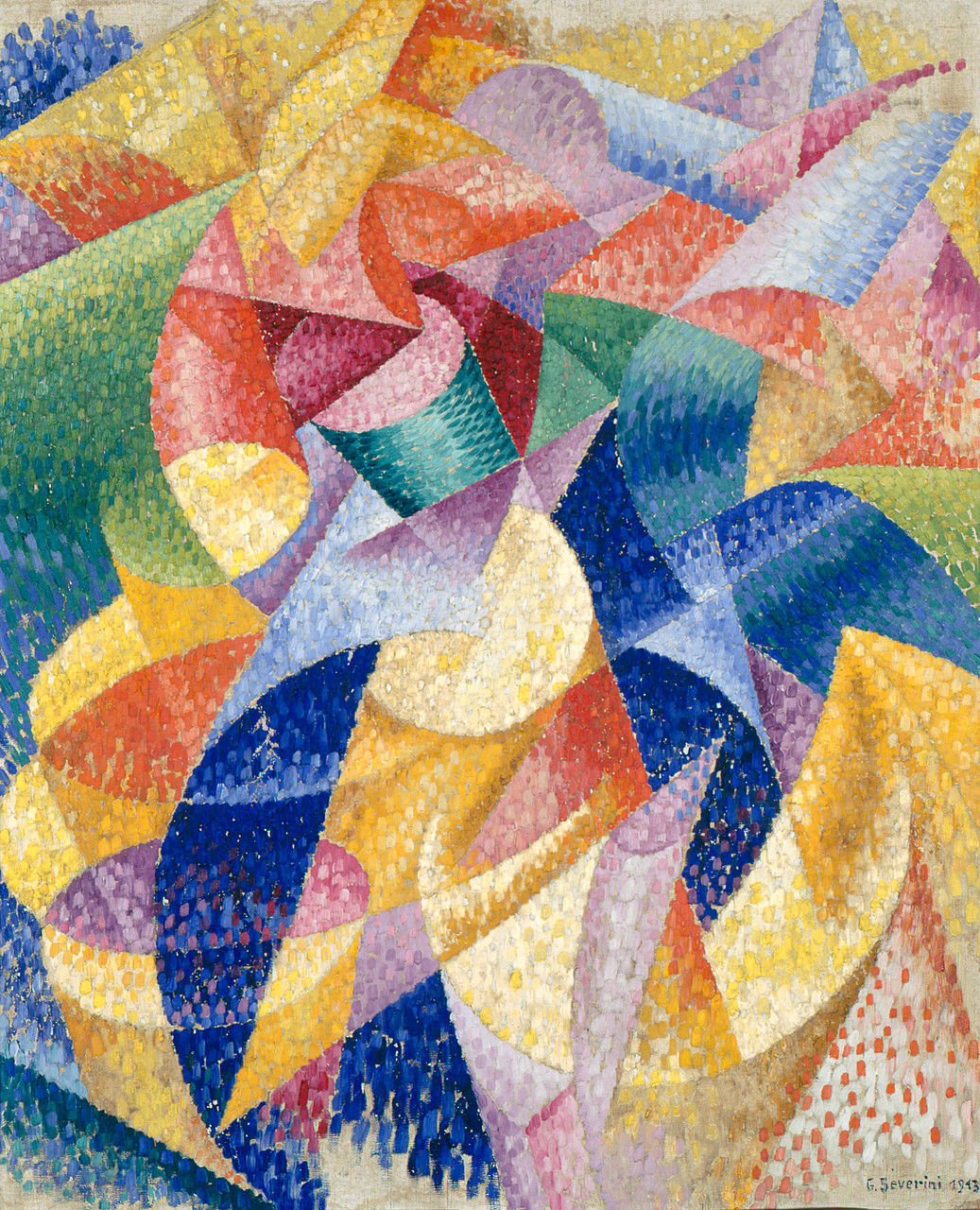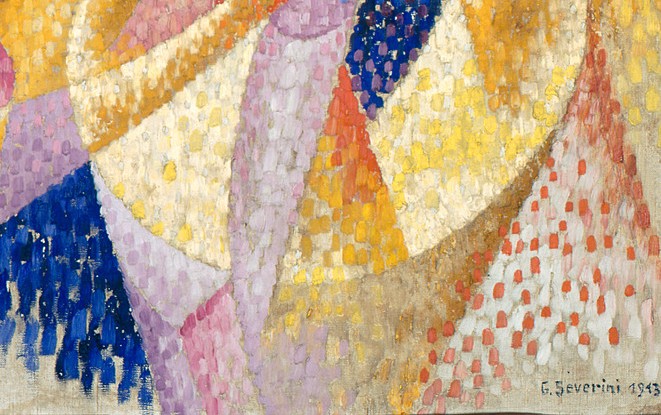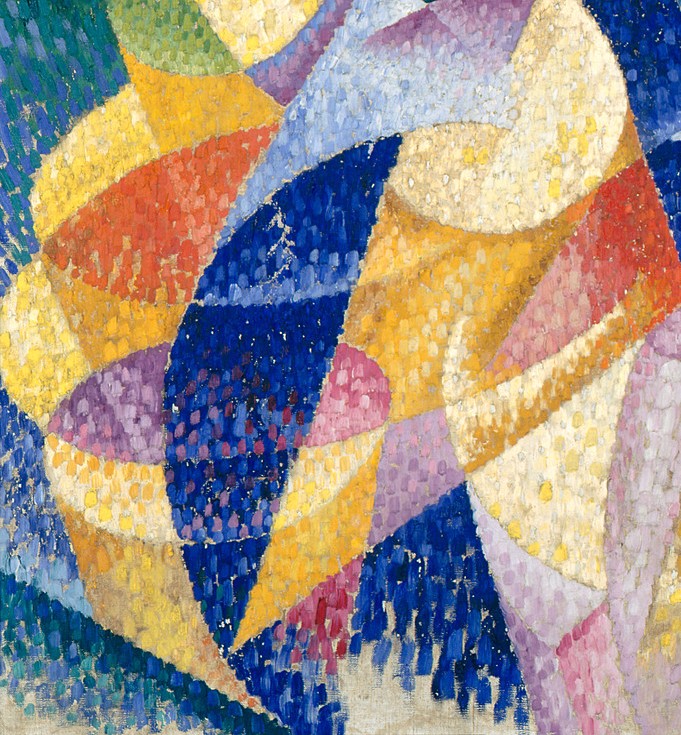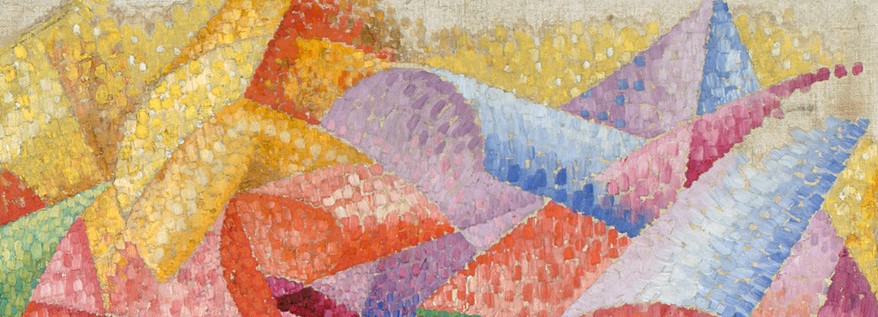Gino Severini painted Sea = Dancer in oil on canvas, in 1914. This painting is part of the Peggy Guggenheim Collection in Venice.

What is depicted in the Sea = Dancer?
The visual solution of this composition corresponds to the idea of plastic analogies developed by Severini. The sense of space is based on the optical determination, which is fluid. Thus the human figure becomes inseparable from reality and viewed as a total sensation of movement. Severini further enhances the pulsating character of the painting by arranging almost mosaically small fields of complementary colors.
The Sea = Dancer – Analysis
Gino Severini had a significant role in the Futurist movement. Having lived in Paris since 1906, this painter will become the first connection between the Cubists and Futurists. Severini participated in the organization of the first Futurist exhibition outside Italy at the Galerie Bernheim-Jeune in Paris, in 1912. Of crucial importance for the formulation of Futurist aesthetics was familiarity with the Cubist approach to painting. Cubist innovations were reflected in geometrization, fragmentation, and mobile perspective, and all three largely determined the development of Futurist painting.

Geometrization
Geometrization is one of the key elements of cubist and futurist painting. By departing from the traditional principles of mimetic painting, cubism generated a new language of which geometrization was a significant part. Geometrization achieved the effect of flatness – authentic two-dimensionality that belongs to the medium of painting. In defining this method, Cubists were guided by the ideas of Paul Cezanne about the possibility of reducing all scenes in nature to geometric bodies. The Futurists completely took over this painting formula, emphasizing geometrization as a component that unites the language of technique and the language of visual art. Geometrization was developed in futurist painting not through the prism of the genesis of the artistic language to authentic two-dimensionality, as is the case with Cubism, but through the visual prism of modernization, industrialization, and the technological revolution that it was meant to point that.
Futurism adopted the Cubist principles of scene fragmentation as well. As a continuation of Cezanne’s ideas about the new visual capacities brought by the inverse perspective, the Cubists divided the scene into several angles from which it can be viewed. Fragmentation has become a major tool for deconstructing traditional perspective frames. This procedure was developed by the Futurists, especially in the domain of representing the dynamism of urban spaces as well as the speed of cars or people in motion as is the case with the Sea = Dancer.

Divisionism
Divisionism is a scientific approach to painting that was based on modern achievements in the field of optics in the 19th century. These achievements are related to the unique qualities of the primary colors and their mutual relationship in the image without prior mixing of pigments. This theory served as the basis for numerous painting methods that emerged during and after post-impressionism. Scientists whose discoveries are fundamental for the divisionist technique are Michel Eugène Chevreul, James Clerk Maxwell, Ogden Rood, and Charles Blanc.
The processes that the observer’s eyes go through when looking at an image are the focus of divisionist theory. Scientists and later painters insisted that properly arranged complementary colors on the painted composition could convey to the observer the qualities of colors and shades that do not exist individually on the canvas. So the process of mixing colors and nuances of tones would actually take place in the eye of the beholder, while the canvas itself would be the basis for the optical mixing
Gino Severini together with Umberto Boccioni and a couple of other painters wrote in the Technical Manifesto of Futurist Painting :
Your eyes, accustomed to semi-darkness, will soon open to more radiant visions of light. The shadows which we shall paint shall be more luminous than the highlights of our predecessors, and our pictures, next to those of the museums, will shine like blinding daylight compared with the deepest night.
We conclude that painting cannot exist today without Divisionism. This is no process that can be learned and applied at will. Divisionism, for the modern painter, must be an innate complementarity that we declare to be essential and necessary.

In the Sea = Dancer, the divisionist technique was of predominant importance for achieving the effect of all-pervading movement. The relationship between warm and cold colors as well as the vibrancy achieved by the juxtaposition of different tones within the same color field contributed to the distinct dynamism of the composition.
Unlike other Futurists who often treated motifs from the field of industry and traffic, Severni developed the phenomenon of dynamism of movement through the human figure. Dealing with the very popular theme of the early modern period, i.e. the Parisian dancer, Severini breathed into it a specifically futurist scientistic element. Severini in Sea = Dancer through the highly geometrized structure generates his authentic abstract language and refers to the idea of an all-pervading sensation of movement that he was developing.
That concept referred to the representation of the experience of movement by merging all moving forms in a given scene. In the painting Sea = Dancer, the movement of the dancer’s body, then the movement of her costume, and finally the movement of the waves are represented by geometrical means. All three layers of movement are synthesized into one complex experience of dynamism. In making this painting, Severini also painted the frame. This is what the Futurists often did, and by leaving the traditional field of painting, they additionally emphasized the experience of movement as their primary focus.
Related Artworks
A similar concept was applied by Severini in the painting Dancer = Propeller = Sea from 1915.
